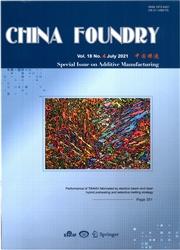Microstructure and mechanical properties of Fe/NbC composite layer prepared by in-situ reaction
IF 2.3
3区 材料科学
Q2 Materials Science
引用次数: 0
Abstract
NbC ceramic surface-reinforced steel matrix composites were prepared by an in-situ reaction method at different temperatures (1,050 °C, 1,100 °C and 1,150 °C) for different times (1 h, 2 h and 3 h). The phase constitution, microstructure and fracture morphology of NbC ceramic surface-reinforced steel matrix composites were analyzed by XRD, SEM and EDS, and the effects of the in-situ reaction temperature and time on the mechanical properties were systematically studied. The results indicate that the NbC reinforcement layer is formed through the reaction between Nb atoms and carbon atoms diffused from the steel matrix to the Nb plate. The thickness of this reinforcement layer increases as the reaction time prolongs. Additionally, an increase in reaction temperature results in a thicker reinforcement layer, although the rate of increase gradually decreases. The relationship among the thickness of the NbC reinforcement layer, the reaction time and temperature was established by data fitting. The optimal tensile performance is achieved at 1,100 °C for 1 h, with a tensile strength of 228 MPa. It is also found that the defects between the reinforcement layer and the steel matrix are related to reaction temperature. At 1,100 °C, these defects are minimal. Fracture mostly occurs in the NbC reinforced layer of the composites, and the fracture mode is characterized by typical intergranular brittle fracture.原位反应制备Fe/NbC复合层的微观结构和力学性能
采用原位反应法制备了NbC陶瓷表面增强钢基复合材料,反应温度分别为1050℃、1100℃和1150℃,反应时间分别为1 h、2 h和3 h。采用XRD、SEM和EDS分析了NbC陶瓷表面增强钢基复合材料的相组成、显微组织和断口形貌,并系统研究了原位反应温度和时间对复合材料力学性能的影响。结果表明,NbC强化层是由Nb原子与从钢基体扩散到Nb板的碳原子反应形成的。随着反应时间的延长,增强层的厚度增加。另外,随着反应温度的升高,增强层变厚,但增加速率逐渐减小。通过数据拟合,建立了NbC增强层厚度与反应时间、温度之间的关系。在1100℃下,拉伸时间为1 h,拉伸强度为228 MPa,达到最佳拉伸性能。同时发现增强层与钢基体之间的缺陷与反应温度有关。在1100℃时,这些缺陷是最小的。断裂主要发生在复合材料的NbC增强层,断裂方式为典型的晶间脆性断裂。
本文章由计算机程序翻译,如有差异,请以英文原文为准。
求助全文
约1分钟内获得全文
求助全文
来源期刊

China Foundry
工程技术-冶金工程
CiteScore
2.10
自引率
25.00%
发文量
1646
审稿时长
3.0 months
期刊介绍:
China Foundry, published bimonthly to a worldwide readership, mainly reports on advanced scientific and technical achievements, applied technology, production successes, management and leadership, recent developments and industry information in the foundry field. Coverage encompasses all casting technologies and includes, but is not limited to, novel and net shape casting technologies; casting alloy design and modification; control of nucleation, solidification and microstructure & mechanical properties; computer aided design; rapid prototyping; mold making, mold materials and binders; mold and gating design; melting and liquid-metal treatment and transport; modeling and simulation of metal flow and solidification; post-casting treatments; quality control and non-destructive testing; process automation and robotics; and safety and environmental issues.
 求助内容:
求助内容: 应助结果提醒方式:
应助结果提醒方式:


